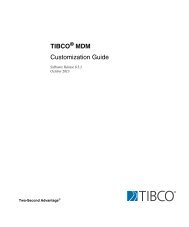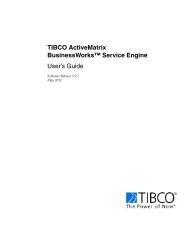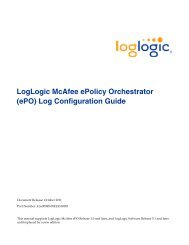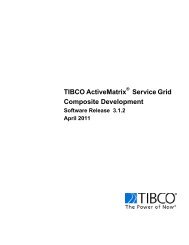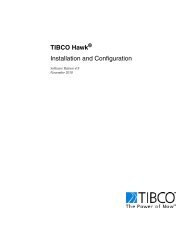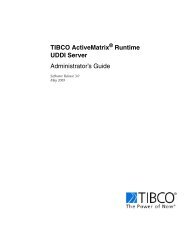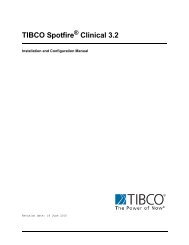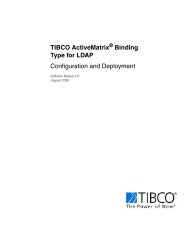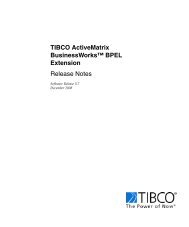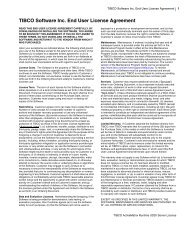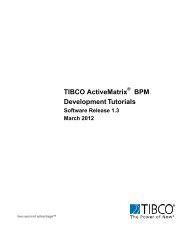TIBCO Spotfire Server 3.2.2 - TIBCO Product Documentation
TIBCO Spotfire Server 3.2.2 - TIBCO Product Documentation
TIBCO Spotfire Server 3.2.2 - TIBCO Product Documentation
You also want an ePaper? Increase the reach of your titles
YUMPU automatically turns print PDFs into web optimized ePapers that Google loves.
Backup and Restore<br />
• HTTPS (see the section “Setting up HTTPS on a <strong>Spotfire</strong> <strong>Server</strong>” on page 86 for<br />
more information about this)<br />
• Authentication such as Kerberos, NTLM, or Client Certificates (see the section<br />
“Authentication and User Directory” on page 65 for more information about<br />
this).<br />
• Shared Disk. In a cluster of more than one server, you may want to configure the<br />
location of the Shared Disk (see the section “Shared Disk Location in a<br />
Clustered Environment” on page 100 for more information about this).<br />
• Configuration regarding data sources. Each <strong>Spotfire</strong> <strong>Server</strong> needs configuration<br />
regarding database drivers etc for external data sources.<br />
• Any other advanced configuration performed in “Advanced Procedures” on<br />
page 84. When performing advanced configuration, you should always take<br />
backup into consideration.<br />
To back up your <strong>Spotfire</strong> <strong>Server</strong>(s), you should select one of the following methods:<br />
• Back up the entire machine that <strong>Spotfire</strong> <strong>Server</strong> is running on.<br />
• Back up only the files that <strong>Spotfire</strong> <strong>Server</strong> installs on the machine.<br />
There are of course advantages and drawbacks with whichever method you select. If<br />
you back up the entire machine, you will be certain that no files are missing in your<br />
backup. On the other hand, you also have a backup that includes an entire computer<br />
with potentially other software running on it, that you may not want to restore after a<br />
crash. If you run only <strong>Spotfire</strong> <strong>Server</strong> on the machine, this is probably what you should<br />
choose.<br />
If you back up only the files that the <strong>Spotfire</strong> <strong>Server</strong> installs in the , you will potentially have a backup that is more easy to move between<br />
machines. You should however take special notice to back up anything you may have<br />
stored or configured outside the <strong>Spotfire</strong> <strong>Server</strong> installation directory. A typical<br />
example of this would be database drivers necessary to connect to Information<br />
Sources, set up in the Control Panel if running on Windows. Backing up the entire<br />
machine would back up these dependencies as well. Also, if you are running <strong>Spotfire</strong><br />
<strong>Server</strong> on Windows, you will lose the Start Menu shortcuts and the unistall feature in<br />
the Control Panel when restoring this type of backup.<br />
For both methods, you should also consider that authentication such as Kerberos and<br />
Client Certificates could be difficult to restore, due to the fact that their configuration<br />
is tied to the specific hardware they are installed on. If you restore a backup to a<br />
machine different from the original one, you will probably have to set up<br />
authentication anew.<br />
Note that it is not possible to restore a backup of a <strong>Spotfire</strong> <strong>Server</strong> to a machine with a<br />
different operating system than the original one.<br />
For other components in the <strong>Spotfire</strong> system, such as the <strong>Spotfire</strong> Web Player, refer to<br />
their installation manuals for instructions on how to perform backups of them.<br />
If you have more than one <strong>Spotfire</strong> <strong>Server</strong> in the cluster, and they are configured<br />
differently, remember to perform backups of each server.<br />
<strong>TIBCO</strong> <strong>Spotfire</strong>® <strong>Server</strong> <strong>3.2.2</strong> 129 (144)



